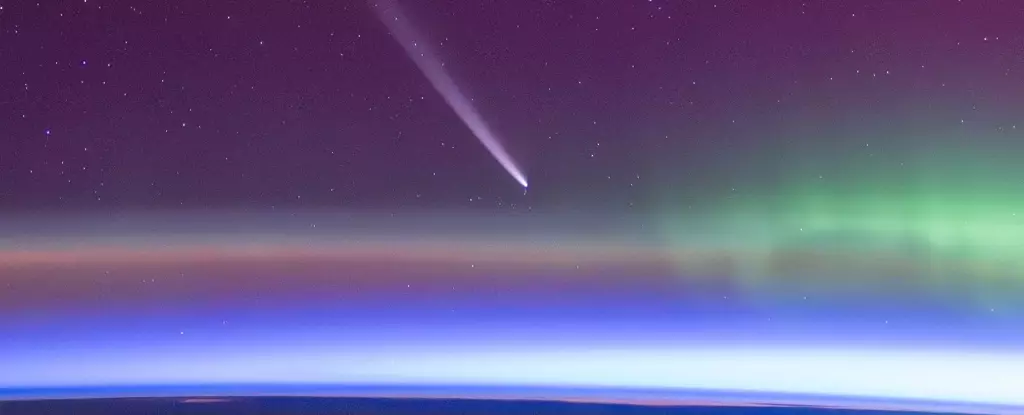The Oort Cloud, an integral yet elusive component of our solar system, stretches far beyond the orbits of the planets we see. Conceived as a vast, spherical shell of icy bodies, this cosmic cloud forms a protective barrier around our sun and its planetary companions. Despite being theorized since the mid-20th century, direct observation of the Oort Cloud remains impossible due to its vast distance and tenuous constitution. Its particles are scattered across trillions of miles in deep space, shrouded in darkness, which renders it effectively invisible. Yet, its existence is inferred through the behavior of certain comets that make sporadic visits to the inner solar system.
This year’s astronomical events have brought forth a fascinating spectacle with the passage of two comets, providing a rare opportunity for stargazers. First, there is Tsuchinshan-ATLAS, or Comet C/2023 A3, expected to be at its most brilliant around October 12. Observers can look towards the western sky shortly after sunset to catch a glimpse. Following this, C/2024 S1 (ATLAS) is anticipated to be visible around late October, particularly before dawn in the eastern sky. Both of these comets are linked to the Oort Cloud and serve as reminders of the ancient and distant parts of our solar system that can send icy messengers into our vicinity.
While the allure of these celestial visitors captivates many, there lies a profound interplay between their beauty and the potential chaos they may bring. With their icy nuclei, comets such as those emerging from the Oort Cloud may have been responsible for delivering water to our planet, possibly aiding the genesis of life as we know it. However, the same materials also pose a significant risk, with impacts from Oort Cloud objects having the power to disrupt life on Earth dramatically.
The groundwork for understanding this vast realm was laid by the Dutch astronomer Jan Oort in 1950, who theorized the existence of the cloud while examining long-period comets. Oort’s calculations suggested that these comets originated from a distant place more than 10,000 astronomical units from the Sun, which is equivalent to billions of miles. By suggesting a population of around 100 billion icy bodies, Oort painted a picture of the Oort Cloud as a vast reservoir brimming with celestial wonders. Nearly seven decades later, astronomers estimate that this mysterious cloud could stretch up to 10 trillion miles across.
The inquiry into these long-period comets is particularly compelling, as their orbits are influenced by the gravitational forces of nearby stars. Their unpredictable trajectories make predicting their path a unique challenge. The stark difference between the long-period and short-period comets is noteworthy, as the latter venture closer within the solar system and are relatively well-known, such as Halley’s comet.
Despite the majestic beauty presented by these wandering bodies, comets originating from the Oort Cloud symbolize both discovery and potential disaster. Think of how a comet arriving from such great distances can suddenly re-enter our cosmic neighborhood after millennia of solitude. Their unpredictable nature could spell doom. For instance, the fictional narrative in the film “Don’t Look Up,” where a comet threatens Earth, resonates with the real danger long-period comets present.
While the odds of a collision with Earth are minuscule, the capacity for devastation remains evident. The recent successes of missions like NASA’s DART, which successfully altered an asteroid’s trajectory, present potential defense strategies. Unlike asteroids, however, there may be little time to prepare before a comet emerges from the shadows, potentially arriving with only weeks or days of notice.
As the scientific quest to explore the Oort Cloud continues, projects like the upcoming European Space Agency’s Comet Interceptor, scheduled for launch in 2029, hold promise. This mission aims to study a newly discovered comet from the Oort Cloud, providing crucial insights into the genesis of our solar system. The impending Legacy Survey of Space and Time, set to start at the Rubin Observatory in 2025, may also enrich our understanding of these ancient icy bodies.
With advancements in telescopic technology, astronomers hope to broaden our knowledge and catalog the existing 4,500 known Oort Cloud comets. A greater understanding of size, composition, and behavior could be pivotal in safeguarding Earth against these intriguing yet dangerous celestial wanderers.
As we marvel at the upcoming comets and ponder the vastness of the Oort Cloud, we embark on a journey merging beauty and fragility, reminding us of the delicate balance within our cosmic domain. Peering into the sky in search of these stellar narratives allows us to appreciate both the serenity and the underlying chaos of our universe.


Leave a Reply